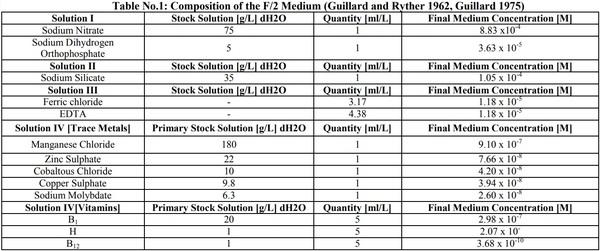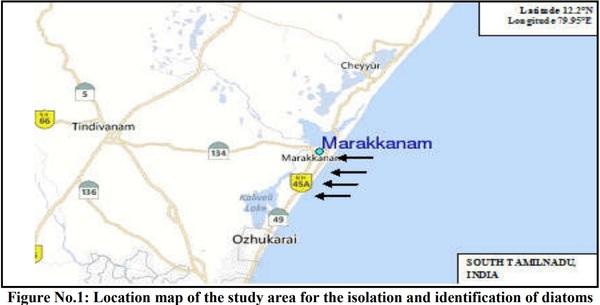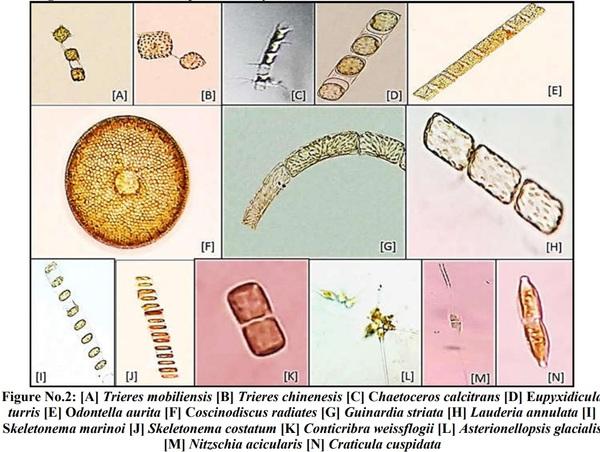Larger Diatom Flora Isolated and Identified from the Northeast Pelagic Seacoast of Marakkanam, Tamil Nadu, India





1. Davis R B. Paleolimnological diatom studies of acidification of lakes by acid rain: An application of Quaternary science,
Quaternary Scie Revi, 6(2), 1987, 147-163.
2. Bentley K, Cox E J, Bentley P J. Nature's batik: A computer evolution model of diatom valve morphogenesis, Journal of Nanoscience and Nanotechnology, 5(1), 2005, 25-34.
3. Armbrust E V, Berges J A, Bowler C, Green
B R, Martinez D, Putnam N, Zhou S, Allen A
E, Apt K E, Bechner M, Brzezinski M A,
Chaal B K, Chiovitti A, Davis A K, Demarest
M S, Detter J C, Glavina T, Goodstein D,
Hadi M Z, Hellsten U, Hilldebrand M,
Jenkins B D, Jurka J, Kapitonov V V, Kroger
N, Lau W W Y, Lane T W, Larimer F W,
Lippmeier J C, Lucas S, Medina M, Monstant
A, Orbornik M, Parker M S, Palenik B,
Pazour G J, Richardson P M, Rynearson T A,
Saito M A, Schwartz D C, Thamatakoln K,
Valentin K, Vardi A, Wilkerson F P, Rokshar
D. The genome of the diatom Thalassiosira pseudonana: Ecology, evolution and metabolism, Science, 306(5693), 2004, 79-86.
4. Mishra S, Gupta A K, Mishra M K Mishra V.
Study on variation of diatoms in Gomati
River at Jaunpur for forensic consideration,
Journal of Pharmacy and Biol. Sciences,
11(4), 2016, 59-62.
5. Round F E. Diatoms in river watermonitoring studies, Journal of Applied
Physiology, 3(2), 1991, 129-145.
6. Nelson D M, Treguer P, Brzezinski M A,
Leynaert A, Queguiner B. Production and dissolution of biogenic silica in the ocean:
Revised global estimates, comparison with regional data and relationship to biogenic sedimentation, Glob. Biogeochem. Cycles,
9(3), 1995, 359-372.
7. Field C B, Behrenfeld M J, Randerson J T,
Falkowski P. Primary production of the biosphere: Integrating terrestrial and oceanic components, Scie, 281(5374), 1998, 237-240.
8. Buesseler K O, Andrews J E, Pike S M.
Particle export during the Southern Ocean iron experiment (SOFeX), Limnol Oceanogr,
50(1), 2005, 311-327.
9. Romero O E, Armand L K. Marine diatoms as indicators of modern changes in oceanographic conditions, In: The Diatoms,
Applications for the environmental and earth sciences, Cambridge University Press,
Cambridge, 2nd Edition, 2010, 373-400.
10. Rigual-hern´andez A S, Trull T W, Bray S G.
Seasonal dynamics in diatom and particulate export fluxes to the deep sea in the Australian sector of the southern Antarctic Zone, J Mar
Syst, 142, 2015, 62-74.
11. Assmy P, Smetacek V and Montresor M.
Thick-shelled, grazerprotected diatoms decouple ocean carbon and silicon cycles in the iron-limited Antarctic circumpolar current, Proc Natl Acad Sci, 110(51), 2013,
20633-20638.
12. Qu´eguiner B. Iron fertilization and the structure of plank tonic communities in high nutrient regions of the Southern Ocean, Deep
Sea Res Part II Top St Ocea, 90, 2013, 43-54.
13. Sackett O, Armand L, Beardall J. Taxonspecific responses of Southern Ocean diatoms to Fe enrichment revealed by synchrotron radiation FTIR micro spectroscopy,
Biogeosciences, 11(20), 2014, 5795-5808.
14. Supriya G, Ramachandra T V. Chronicle of marine diatom culturing techniques, Indian
Journal of Fundamental and Applied Life
Sciences, 1(3), 2011, 282-294.
15. Muller O F. Diatomaceen (Vibrio paxillifer,
V. bipunctatus, V. tripunctatus, Gonium pulvinatum). The small animals of the sea and the lips on each of the things that has unfolded to fluviatilia, systematically, according to the writing and to make a living to sketch the cured, Animalcula infusoria,
Havniae, Nauturque curiosol, Berlin, 1786.
16. Medlin L K, Kooistra W H C F, Gersonde R,
Wellbrock U. Evolution of the diatoms (Bacillariophyta). II, Nuclear-encoded small-subunit rRNA sequences comparisons confirm paraphyletic origin for centric diatoms, Molecular and Biological Evolution,
13(1), 1996, 67-75.
17. Karthick B, Taylor J C, Mahesh M K,
Ramachandra T V. Protocols for collection, preservation and Enumeration of diatom from
Aquatic habitats for water quality monitoring in India, The IUP Journal of Soil and Water
Sciences, 3(1), 2010, 25-60.
18. Mann D G, Thomas S J, Evans K M.
Revision of the diatom genius: Sellaphora: A first account of the larger species in the
British Isles, Fottea, 8(1), 2008, 15-78.
19. Falasco E, Bona F, Badino G, Hoffmann L,
Ector L. Diatom teratological forms and environmental alterations: A review,
Hydrobiologia, 623(1), 2009, 1-35.
20. Hakansson H, Chepurnov V. A study of variation in valve morphology of the diatom
Cyclotella meneghiniana in monoclonal cultures: Effect of auxospore formation and different salinity conditions, Diatom
Research, 14(2), 1999, 251-272.
21. Miquel P. De la culture artificielle des diatomees, Cultures pures des diatomees, Le
Diatomiste, (1), 1890, 149-156.
22. Price N M, Harrison G I, Hering J G, Hudson
R J, Nirel P M V, Palenik B, Morel F M M.
Preparation and chemistry of the artificial culture medium, Aquil. Biological
Oceanography, 6(5-6), 1989, 443-461.
23. Keller M D, Bellows W K and Guillard R R
L. Microwave treatment for sterilization of phytoplankton culture media, Journal of
Experimental Marine Biology and Ecology,
117(3), 1988, 279-283.
24. Zengler K. Central role of the cell in microbial ecology, Microbiology and
Molecular Biolo Revi, 73(4), 2009, 712-729.
25. Guillard R R L. Culture of phytoplankton for feeding marine invertebrates, In: Culture of marine invertebrate animals (Ed. by Smith
W.L. and Chanley M.H.) Plenum Press, New
York, USA, 1975, 26-60.
26. Guillard R R, Ryther J H. Studies on marine plank tonic diatoms. Cyclotella nana Hustedt and Detonula confervacaea (Cleve) Gran,
Cana J Microbiol, 8(2), 1962, 229-239.
27. Battarbee R W. Diatom Analysis. In:
Handbook of holocene paleoecology and paleohydrology (Ed. by Berglund B.E.) John
Wiley and Sons Ltd, Great Britain, Journal of
Quaternary Science, 1(1), 1986, 86-87.
28. Andersen R A, Kawachi M. Traditional
Microalgae Isolation Techniques, Chapter 6.
In: Algal culturing techniques (Ed. by
Andersen R.A.), Elsevier, 2005, 83-100.
29. Cullen J J, Macintyre H L. On the use of the serial dilution culture method to enumerate viable phytoplankton in natural communities of plankton subjected to ballast water treatment, J Appl Phycol, 28(1), 2016, 279-
298.
30. Stein E D. Handbook of Phycological
Methods, Culture methods and growth measurements, Cambridge University Press,
Cambridge, 1973-1985.
31. Barker K. At the Bench: A laboratory navigator, Cold spring harbor, Cold Spring
Harbor Laboratory Press, New York, USA,
1998.
32. Knuckey R M, Brown M R, Barrett S M,
Hallegraeff G M. Isolation of new nanoplanktonic diatom strains and their evaluation as diets for juvenile Pacific oysters (Crassostrea gigas), Aquaculture, 211(1-4),
2002, 253-274.
33. Yamaji I. Illustration of the marine plankton of Japan, Hoikusha Publishing Co. Ltd,
Osaka, Japan, 1976, 369.
34. Newell G E, Newell R C. Marine plankton, A practical guide, Hutchinson of London, 5th
Edition, 1977, 244.
35. Tomas C R. Identifying marine phytoplankton, Academic Press, London,
1997, 858.
36. Barsanti L, Gualtieri P. Algae: anatomy, biochemistry and biotechnology, Taylor and
Francis, Boca Raton, FL, 2006, 301.
37. Guiry M D. Guiry G M. Algae Base, Worldwide electronic publication, National
University of Ireland, Galway, 2020.
38. Bailey J W. Microscopical observations made in South Carolina, Georgia and
Florida, Smithsonian Contributions to
Knowledge, 2(8), 1851, 1-48.
39. Ashworth M P, Nakov T and Theriot E C.
Revisiting Ross and Sims (1971), toward a molecular phylogeny of the Biddulphiaceae and Eupodiscaceae (Bacillariophyceae), Jour of Phyco, 49(6), 2013, 1207-1222.
40. Greville R K. Descriptions of new and rare diatoms, Series XIX, Transactions of the microscopical society, New Series, 14, 1866,
77-86.
41. Takano H. On the diatom Chaetoceros calcitrans (Paulsen) emend and its dwarf form pumilus forma nov, Bulletin Tokai
Regional Fisheries Research
Laboratory, 55(7), 196, 1-7.
42. Pritchard A. A history of infusoria, including the Desmidiaceae and Diatomaceae, British and foreign. Fourth edition enlarged and revised by Arlidge J T, Lond B A, W Archer
ESQ, J Ralfs M R CSL, W C Williamson ES
Q, F R S and the Author, Whittaker and Co,
Av Ma La, Lon, 4th Edition, 1(98), 1861, 1-12.
43. Blanco S, Wetzel C E. Replacement names for botanical taxa involving algal genera, Phytotaxa, 266(3), 2016, 195-205.
44. Agardh C A. Conspectus criticus diatomacearum, Lundae [Lund], Literis
Berlingianus, 4, 1832, 49-66.
45. Ehrenberg C G. Uber noch zahlreich jetzt lebende Thierarten der Kreidebildung und den
Organismus der Polythalamien Preprint of
Abhandlung der Konglichen Akademie der
Wissenschaften zu Berlin aus dem Jahre 1839
[1841] with different pagination, Berlin, 4,
1840, 1-94.
46. Hasle G R, Syvertsen E E. Marine diatoms,
In: Identifying marine phytoplankton, (Tomas, C.R. Eds, San Diego: Academic
Press, 1996, 5-385.
47. Cleve P T. Examination of diatoms found on the surface of the Sea of Java, Bihang till
Kongliga Svenska Vetenskaps-Akademiens
Handlingar, 1(11), 1873, 1-13.
48. Sarno D, Kooistra W H C F, Medlin L K,
Percopo I, Zingone A. Diversity in the genus Skeletonema (Bacillariophyceae): II.
An assessment of the taxonomy of S. costatum-like species, with the description of four new species, Journal of
Phycology, 41(1), 2005, 151-176.
49. Fryxell G A, Hasle G R. The genus Thalassiosira: Species with a modified ring of central strutted processes, In:
Proceedings from the fourth symposium on recent and fossil marine diatoms, Oslo,
August 30 - September 3, 1976. (Simonsen,
R. Ed.), Beihefte Zur Nova Hedwigia, 54,
1977, 67-98.
50. Stachura Suchoples K, Williams D M.
Description of Conticribra tricircularis, A new genus and species of Thalassiosirales, with a discussion on its relationship to other continuous cribra species of Thalassiosira Cleve (Bacillariophyta) and its fresh water origin, European Journal of
Phycology, 44(4), 2009, 477-486.
51. Round F E, Crawford R M. Mann D G. The diatoms biology and morphology of the genera, Cambridge University Press,
Cambridge, 1990, 1-747.
52. Smith, W. A synopsis of the British
Diatomaceae; with remarks on their structure, function and distribution and instructions for collecting and preserving specimens, The plates by Tuffen West, John van Voorst,
Paternoster Row, London, 1(2), 1853, 1-89.
53. Kutzing F T. Die Kieselschaligen Bacillarien oder Diatomeen, Nordhausen: Zu finden bei
W, Kohne, 1(7), 1844, 1-30.
54. Muller-Feuga A, Moal J. Kaas R. The microalgae of aquaculture, In: Live feeds in marine aquaculture (Ed. by J.G. Stottrup and
L.A. Mc Evoy), Black Scie, 2003, 206-252.
55. Benemann J. Microalgae for biofuels and animal feeds, Ener, 6(11), 2013, 5869-5886.
56. Victor A C, Claas G S, Phil S. Diatoms as hatchery feed: On-site cultivation and alternatives, Hatchery feed, 6(3), 2018, 23-27.
57. James M G, Linda E G, Shahrizim B Z, Brian
F P, Spencer W H, Jun Y. Freshwater diatoms as a source of lipids for biofuels, J Ind
Microbiol Biotechnol, 39(3), 2012, 419-428.
58. Mayavan V, Rajeswari Thangavel B.
Comparative study on growth of
Skeletonema costatum: Amicroalga as live feed for aquaculture importance,
International Journal of Research in
Fisheries and Aquacul, 4(3), 2014, 117-121.
59. Soliman H, Abdel R Abdel Razek F A,Abou
Zeid A E, Mohamed A. Optimum growth conditions of three isolated diatom species;
Skelatonema costatum, Chaetoceros calcitrans and Detonulla confervacea and their utilization as feed for marine penaeid shrimp larvae, Egyptian Journal of Aquatic
Research, 36(1), 2010, 161-183.
60. Ortega-salsa A A, Pedro Flores N. Cultivation of the Microalga Thalassiosira weissflogii to feed the Rotifer Brachionus rotundiformis, J
Aquac Mar Biol, 6(5), 2017, 00169.
61. Goiris K, Muylaert K, Fraeye I, Foubert I De
Brabanter J, De Cooman L. Antioxidant potential of microalgae in relation to their phenolic and carotenoid content, J. Appl.
Phycol, 24(6), 2012, 1477-1486.
62. Goiris K, Van Colen W, Wilches I, LeonTamariz F, De Cooman L, Muylaert K.
Impact of nutrient stress on antioxidant production in three species of microalgae, Algal Res, 7, 2015, 51-57.
63. Nash C E, Kuo C M. Hypotheses for problems impeding the mass propagation of grey mullet and other finfish,
Aquaculture, 5(2), 1975, 119-134.
64. Pytlik N, Kaden J Finger M, Naumann J,
Wanke S, Machill S, Brunner E. Biological synthesis of gold nanoparticles by the diatom Stephanopyxis turris and in vivo
SERS analyses, Algal Res, 28, 2017, 9-15.
65. Haimeur A, Ulmann L, Mimouni V, Gueno F,
Pineau-Vincent F, Meskini N, Tremblin G.
The role of Odontella aurita, a marine diatom rich in EPA, As a dietary supplement in dyslipidemia, platelet function and oxidative stress in high-fat fed rats, Lipids in health and disease, 11, 2012, 147.
66. Selva Kumar P, Athia S, Umadevi K, Ajith H.
Checklist, Qualitative and quantitative analysis of marine microalgae from offshore
Visakhapatnam, Bay of Bengal, India for biofuel potential, In book: Microalgal biotechnology, Intechopen, 2018, 1-27.
67. Thomas K, Marella A, Itzel Y, LopezPacheco B, Roberto parra-saldivar B,
Sreenath dixit A, Archana T . Wealth from waste: Diatoms as tools for phycoremediation of wastewater and for obtaining value from the biomass, Science of the Total
Environment, 724, 2020, 137960.
68. Wen Z Y, Chen F. Heterotrophic production of eicosapentaenoid acid by the diatom
Nitzschia laevis: Effects of silicate and glucose, J Ind Microbiol Biotechnol, 25(4),
2000, 218-224.
69. Wen Z Y, Chen F. Heterotrophic production of eicosapentaenoic acid by microalgae,
Biotechnol Adv, 21(4), 2003, 273-294.


